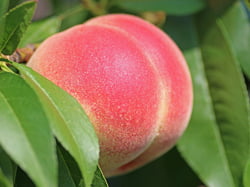By Jesse Eastman
 Nothing defines these hot lazy days of late summer better than a sweet juicy peach. Did you that the only thing better than a Colorado-grown peach bought at a farmer’s market is a peach grown in your own yard? Peaches make excellent landscape trees, are easy to care for, and you get the freshest peaches imaginable! Here are 5 tips to help you successfully grow your own juicy delights.
Nothing defines these hot lazy days of late summer better than a sweet juicy peach. Did you that the only thing better than a Colorado-grown peach bought at a farmer’s market is a peach grown in your own yard? Peaches make excellent landscape trees, are easy to care for, and you get the freshest peaches imaginable! Here are 5 tips to help you successfully grow your own juicy delights.
- Fall Planting
While peach trees can be planted successfully nearly any time of year, the highest success rate is found in fall-planted trees. The soil temperature stays elevated long after our daytime temps have dropped, encouraging root growth. The trees are going dormant, so they don’t need to spend energy supporting fruit and foliage, and can instead divert all their energy to getting a healthy root system established. This allows them to overcome transplant shock while they’re dormant and sets them up to grow like mad the following spring! - Trunk Wrap and Winter Watering
This advice is true for all trees, and peaches are no exception. Colorado winters are dry (even our snow has a very low moisture content), but the sun can still be intense. Use a trunk wrap to protect the bark from drying and splitting from November to March. Make sure to use products designed for this purpose, as improper wrapping may cause more damage than no wrap at all. Water your peach trees 1-2 times per month throughout the winter to prevent the roots from freeze-drying in the ground. This is especially critical for new trees that have been planted within the last 3 years. - Watch for Pests
Peaches and other stone fruits are prone to a number of pests in this region. With prompt treatment, none of these pests are particularly problematic, but left unchecked, they can ruin your dreams of homegrown peaches. Some of the most common pests include aphids, cytospora canker, and peach-tree borer. For more information on managing these pests, click here: http://extension.colostate.edu/topic-areas/yard-garden/backyard-orchard-stone-fruits-2-804/ - Structural Pruning
Fully ripe peaches are full of juice, and consequently can be quite heavy. Periodic pruning of trees helps ensure a stable structure that won’t break under the load of all its fruit and can prevent a litany of problems that can result from ugly limb breakage. Maintenance pruning can also help more sunlight penetrate the canopy of the tree, which encourages better fruiting. For tips on pruning fruit trees, click here: http://extension.colostate.edu/topic-areas/yard-garden/training-and-pruning-fruit-trees-7-003/ - Fertilizer
It takes a tremendous amount of energy to produce a good crop of fruit, so feeding your trees is an important step in guaranteeing an abundant crop. We discourage the use of any fertilizer other than a root stimulator in the first two years after planting (we don’t want to encourage limb growth that the roots are unable to support). The third year a peach tree is in your yard, it’s time to start feeding it. We generally recommend low-nitrogen fertilizers for trees and shrubs, our favorite is Jirdon Tree & Shrub Fertilizer (4-10-10). It is always a good idea to get a soil test done prior to major fertilizer applications in order to pick the best fertilizer for your specific soil environment. Here’s a great article from the CSU Extension on fruit tree fertilizing: http://extension.colostate.edu/topic-areas/yard-garden/fertilizing-fruit-trees-7-612/. If you’re having trouble figuring out what’s best for your peach tree, just call us or stop in, we’re happy to answer any questions you may have!
Originally published on August 1st, 2018.
